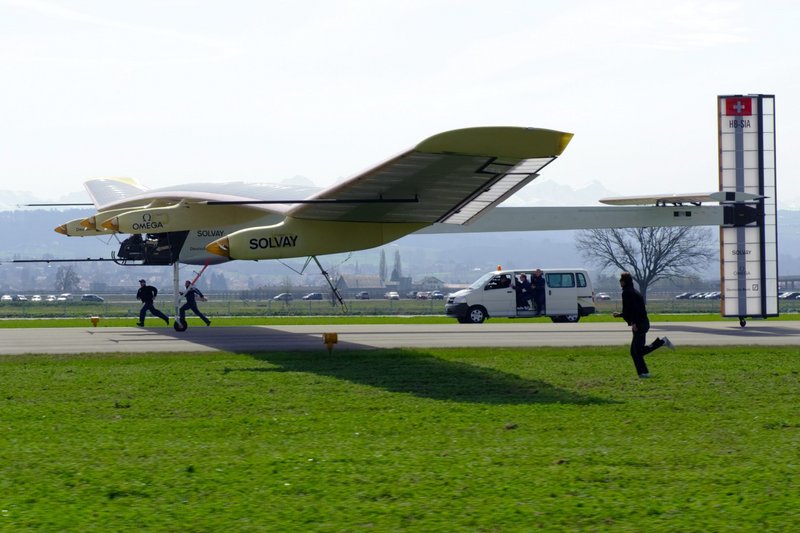PAYERNE, Switzerland — At the pace of a fast bicycle, a solar-powered plane took to the skies for its maiden flight Wednesday, passing an important test on the way to a historic voyage around the world — a journey that would not use a drop of fuel.
The Solar Impulse lifted off from a military airport at a speed no faster than 28 mph (45 kph) after briefly accelerating down the runway. It slowly gained altitude above the green-and-beige fields and eventually faded into the horizon as villagers watched from the nearest hills.
“There has never been an airplane of that kind that could fly — never an airplane so big, so light, using so little energy. So there were huge question marks for us,” said Bertrand Piccard, who is leading the project. In 1999, he copiloted the first nonstop round-the-world balloon flight.
During Wednesday’s 90-minute flight, the plane completed a series of turns by gently tilting its black-and-white wings, which are as wide as those of a 747 jumbo jet. It climbed nearly a mile above the Swiss countryside. The weather was sunny, and there was little wind — obvious advantages for a plane so light and dependent on the sun.
Engineers on the $93.5 million project have been conducting short tests since December, taking the plane no higher than 2 feet and flying no more than 1,000 feet in distance. A night flight is planned before July, and then a second plane will be built based on the results of those tests.
That plane will be the one to attempt the round-the-world flight planned for 2012.
“The goal is to fly day and night with no fuel. The goal is to demonstrate the importance of renewable energies, to show that with renewable energies we can achieve impossible things,” Piccard said.
Aviation experts said they see a future for renewable fuels in commercial aviation, but they predicted that biofuels from plants, algae or other sources were more likely to succeed than solar power.
“Solar energy does not have enough ‘energy density’ to power regular airplanes that are supposed to fly somewhere in a reasonably short time,” said Hans Weber, president of San Diego-based aviation consulting firm TECOP International, Inc. With solar planes, “the objective is only to stay aloft, not to go anywhere fast.”
Test pilot Markus Scherdel said Wednesday’s flight proved that the plane could take off and land safely and handles like a passenger jet.
“Everything worked as it should,” he said.
Using almost 12,000 solar cells, rechargeable lithium batteries and four electric motors, Piccard and co-pilot Andre Borschberg plan to take the plane around the world.
They will make regular stops to switch places and stretch after long periods in the cramped cockpit — and to show off their aircraft.
The circumnavigation will take time. With the engines providing only 40 horsepower, the plane will perform like a moped in the sky, at an average flight speed of 44 mph. The trip will be divided into five stages — keeping the plane in the air for up to five days at a time.
Copy the Story Link
Send questions/comments to the editors.



Success. Please wait for the page to reload. If the page does not reload within 5 seconds, please refresh the page.
Enter your email and password to access comments.
Hi, to comment on stories you must . This profile is in addition to your subscription and website login.
Already have a commenting profile? .
Invalid username/password.
Please check your email to confirm and complete your registration.
Only subscribers are eligible to post comments. Please subscribe or login first for digital access. Here’s why.
Use the form below to reset your password. When you've submitted your account email, we will send an email with a reset code.